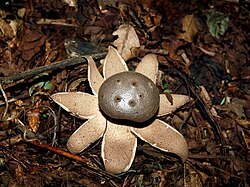| Myriostoma calongei | |
|---|---|
 | |
| Myriostoma calongei, Bolivia | |
| Scientific classification | |
| Kingdom: | Fungi |
| Division: | Basidiomycota |
| Class: | Agaricomycetes |
| Order: | Geastrales |
| Family: | Geastraceae |
| Genus: | Myriostoma |
| Species: | M. calongei |
| Binomial name | |
| Myriostoma calongei Baseia, J.O. Sousa & M.P. Martín (2017) | |
Myriostoma calongei is a fungal species in the family Geastraceae. Basidiocarps resemble earthstars, but the spore sac is supported by multiple columns (instead of a single column) and has multiple ostioles instead of a single, apical ostiole. The fungus was described from Brazil in 2017 as a result of molecular research, based on cladistic analysis of DNA sequences. Previously, it had been identified as Myriostoma coliforme , now known to be restricted to northern, temperate regions. Myriostoma calongei can be distinguished by the conspicuously verrucose (finely warted) endoperidium. [1] The species has also been confirmed from Argentina, [1] Mexico, [2] and the United States (New Mexico). [2] [3]